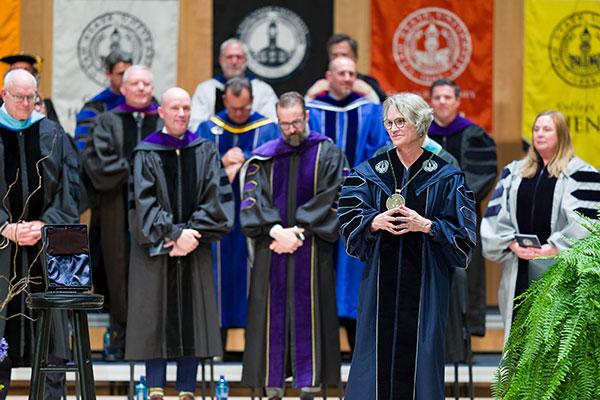
The installation of a new president is a ceremony of dignity with many academic traditions and protocols. It includes an academic procession of delegates from other colleges and universities, as well as the institution’s faculty. Marchers wear the colorful academic regalia of their own alma mater.
Learn about the traditions surrounding a presidential investiture.
The Ceremonial Mace
The history of academic maces dates back to their origins as weapons of war, depicted in ancient Egyptian art. Over time, they were used by campus officials in the Middle Ages to maintain order. Today, university maces primarily serve as symbolic representations of traditions, commonly appearing at solemn events like commencement ceremonies. This symbolism reflects the profound academic journey of students, paralleling the significance of the commencement ceremony itself, which celebrates beginnings and the promise of personal growth through education.
Utah State University’s mace, with its lantern-like head marked with an ‘A,’ serves as a ceremonial beacon inspired by the Luminary ceremony and the tradition of lighting the ‘A’ atop Old Main. While modern, the mace’s enduring design incorporates several elements symbolizing the history and values of Utah State University. At the top of the mace sits a marble known as an Aggie, reminiscent of our institution’s early days as the state’s agricultural college. The mace’s design includes two beehives — one near the top and another at the base — symbolizing the industriousness and vitality of the Beehive State. Depictions of the Aggie bull adorn each corner of the lantern, symbolizing the strength, diligence, and resilience of Utah State Aggies. Below the inscription of ‘USU’ on the mace’s head, thistle vines intertwine, evoking USU’s agricultural heritage as the state’s land-grant university.
Situated at the base of the mace’s light is Utah’s state flower, the Sego Lily, serving as a symbol of the resilience and resourcefulness ingrained in the Aggie family. The mace’s twisted handle represents the staircase found on Old Main Hill and symbolizes progress, growth, and discovery. At the handle’s base lies the university seal, reflecting the three pillars of our foundation as a land-grant institution: research, public service, and teaching. Utah State University’s mace stands as a powerful embodiment of the institution’s rich history, enduring values, and commitment to guiding Aggies toward a bright and prosperous future.
Our deepest appreciation to Joe Needham of S.E. Needham Jewelers and Professor Dennis Hassan and Dean Nicholas Morrison from the Utah State University Caine College of the Arts for their artistic vision and attention to detail in designing and creating the mace.
The Ceremonial Medallion
The presidential medallion plays a pivotal role in the inauguration of a new university president, symbolizing the transfer of authority and marking the commencement of their tenure. Laden with historical and cultural significance, these medallions often feature designs reflecting the university’s values, traditions, and heritage, aligning with other elements of academic regalia like the mace. Worn during official university events, the medallion visually signifies the president’s leadership role and underscores their connection to the institution’s history and values, serving as a tangible representation of academic excellence and institutional governance.
We would like to express our sincere gratitude to O.C. Tanner for their collaboration and impeccable work designing and producing the presidential medallion.

The Regalia
Academic regalia traces its origins back to medieval Europe, when scholars wore robes as a symbol of their status and profession. Over time, these garments evolved into the elaborate caps, gowns, and hoods worn by graduates and faculty in modern universities, reflecting tradition, prestige, and academic achievement. The presidential regalia for today’s investiture includes a ceremonial gown in Utah State University’s institutional colors. The gown is distinguished by Aggie blue velvet panels and showcases two University seals embroidered in silver, representing the institution’s core values, history, and mission. Additionally, it features a fourth chevron denoting the rank of the office and bell sleeves signifying doctoral status. The enduring design of the presidential regalia signifies the authority and dignity of the academic presidency within our institution.
Gowns
The academic gown for the bachelor’s degree has pointed sleeves and is designed to be worn closed. Master’s degree gowns have an oblong sleeve, open at the wrist. The sleeve base hangs down in the traditional manner. The rear part of its oblong shape is square cut, and the front part has an arc cut away. It is designed this way so it can be worn open or closed. The gown for the doctoral degree has bell-shaped sleeves and may be worn open or closed.
Colors
For all academic purposes, including trimmings of doctoral gowns, edging of hoods and tassels of caps, the colors associated with the different academic disciplines are as follows:
Hoods
Academic hoods are worn by recipients of advanced degrees. Master’s degree hoods are three-and-one-half feet in length and lined with the official color(s) of the college or university conferring the degree, which at Utah State University are navy blue and white, displayed in the heraldic chevron. The doctoral hood consists of a larger and longer assemblage of institutional color draped over the recipient’s shoulders, falling well down the back. The binding or edging of the hoods is of velvet or velveteen, three inches wide for the master’s degree and five inches wide for the doctoral degree.
Caps
Academic caps come in two forms: the traditional mortarboard (from Oxford) or square cap; and a soft cap that resembles an oversized beret (from Cambridge). The mortarboard used by Utah State University is worn with a tassel. The color of the tassel designates the graduate’s major field of learning, and gold tassels indicate doctors and the governing officials of institutions.

